.
2.03.2015

India will be launching its fourth navigational satellite as part of the Indian Regional Navigational Satellite System (IRNSS) on 9 March, which will be followed by a series of launches in what will be a busy year for the Indian Space Research Organisation (Isro). The satellite IRNSS-1D will be launched onboard Polar Satellite Launch Vehicle (PSLV-C27), the workhorse rocket of the Indian space agency, at 6.35pm from Satish Dhawan Space Centre in Sriharikota. IRNSS is an independent regional navigation satellite system being developed by India consisting of a constellation seven satellites. It is designed to provide accurate position information service to users in India as well as the region extending up to 1500 km from its boundary, which is its primary service area. . The IRNSS System is expected to provide a position accuracy of better than 20 metres in the primary service area. Three satellites are to be placed in suitable orbital slots in the geostationary orbit, a circular orbit 35,786km above the equator and the remaining four will be placed in geosynchronous orbits which are elliptical orbits designed to keep communication satellites within the view of ground stations. The system will provide two types of services including Standard Positioning Service (SPS) which is provided to all the users and Restricted Service (RS), which is an encrypted service provided only to the authorized users. Some of the applications provided by the IRNSS would be terrestrial, aerial and marine navigation, disaster management, vehicle tracking and fleet management, integration with mobile phones, precise timing, mapping and geodetic data capture, terrestrial navigation aid for hikers and travelers, visual and voice navigation for drivers. “With the launch of the fourth satellite, we will be able to start getting accurate positioning information on the ground and they will start evaluating the proof of concept of the navigation project involving the ground support system,” said the Isro spokesperson. “The final details of the launch countdown are still being looked at by senior officials,” he added. After the launch of a navigational satellite, its solar panels are deployed automatically, and Isro’s master control facility at Hassan, Karnataka, takes control of the satellite. The fifth IRNSS satellite is expected to be launched by September. The navigational system aims to reduce India’s dependence on foreign systems such as the US global positioning system and the Russian global navigation satellite system. The IRNSS launch will be followed by a commercial satellite launch aboard the PSLV and the GSAT-6 satellite launch aboard the GSLV-D6 with an indigenous cryogenic engine. Before the end of the year, the space agency will launch India’s first dedicated astronomical satellite, ASTROSAT.
Quelle: livemint
.
Countdown to IRNSS 1D on March 7
The 59-hour countdown for the launch of IRNSS 1D satellite, which will help India kick-start functioning of indigenous navigation system on a par with the U.S.’ Global Positioning System (GPS), will commence at 7.35 am on March 7.
The launch is scheduled at the first launch pad of Satish Dhawan Space Centre at Sriharikota at 6.35 p.m. on March 9, a senior ISRO official told The Hindu .
Fourth satellite
IRNSS 1D is the fourth of the seven satellites to be launched to put in place India’s very own satellite navigation system, which will be established at a cost of Rs. 1,400 crore.
Though the launch would help the ISRO commence initial operations on the system, the formal commencement of the IRNSS function would be announced a few months later, as the satellite would have to take its final position.
Communication satellite
Following the IRNSS 1D, the ISRO is planning to launch a GSAT-6 communication satellite on board GSLV D-6 rocket with indigenous cryogenic engine by July.
“A foreign satellite on a commercial launch is planned in May onboard a PSLV and we plan to launch IRNSS 1E and Astrosat satellites before the end of this year,” he said.
Quelle: The Hindu
.
ISRO proposes to launch 10 satellites every year
Taking a big step in space exploration, the Indian Space Research Organisation has proposed to launch 10 satellites every year beginning 2015, said S.K. Shivakumar, Director, ISRO Satellite Centre, Bengaluru, here on Sunday.
Speaking at the Science Day celebrations at Sona College of Technology, he said that currently five satellites are launched by India every year of which most of the satellites are for our own use. “We need to expand our space programme and hence, planned for 10 launches from this year,” he added.
He said that India had launched 72 satellites from 1975 till date and the 73{+r}{+d}satellite for navigation is scheduled for March 9 launch. The scientist behind the successful Mars Orbiter Mission said “solving technology challenges in each state, micro level planning, multi-level review and collaborative engineering efforts of all ISRO centres is the success behind our space programme.” He called upon each engineering student to contribute for the nation’s growth through their innovative skills and asked them to be technically updated.
“ISRO welcomes students from all engineering streams as tremendous opportunities are available,” he added. When a student asked why satellites were launched from foreign countries, he said that “it was to exhibit our calibre and strength to foreign nations.”
C. Valliappa, Chairman, Sona Group of Institutions, said that the college is carrying out research for supplying a component for Chandrayaan 2 mission to the ISRO.
He explained the institution’s contribution in supplying various components for ISRO’s earlier missions.
K. Karunakaran, Dean and coordinator for the event, V. Jayaprakash, Principal, C.V. Koushik, Director of Academics, and others spoke.
As part of the week-long Science Day celebrations, exhibitions, paper presentations, quiz and seminar on patent rights were conducted.
About 300 students displayed projects that focused on earthquake resistant building, energy from speed breakers, power generation through water flow in households, mobile security alert and others.
Quelle: The Hindu
.
India will move closer to its own satellite navigation system with the launch of its fourth satellite tentatively slated for March 9, a senior official of the Indian space agency said on Monday.
“The launch is tentatively planned for March 9 evening around 6.35 p.m. However final green signal for the launch will be given days ahead of the satellite launch,” M.Y.S. Prasad, director, Satish Dhawan Space Centre, part of Indian Space Research Organisation (ISRO).
He said the satellite has been tested and mated with the rocket and the heat shield will be closed Monday.
“Full test will be done again Tuesday and the rocket will be moved to the second launch pad on March 4,” Prasad said.
According to him, the space agency’s Launch Authorisation Board (LAB) has to give the final nod for the rocket’s flight.
The LAB meeting is slated for March 6.
The 59 hour countdown is expected to begin on March 7 morning.
Weighing 1,425 kg, the fourth of the Indian Regional Navigation Satellite System (IRNSS) satellite-IRNSS-1D would be flown into space in an Indian rocket called Polar Satellite Launch Vehicle-XL.
After its successful launch and commissioning IRNSS-ID is expected to make India among select group of countries having its own satellite navigation system.
The satellite has a life span of around 10 years.
Currently India is knocking at the door step of an exclusive space club – navigation satellite system owing club – that has the US, Russia, China and Japan as members.
Though the full system comprises of nine satellites – seven in orbit and two on the ground as stand-by – the navigation services could be made operational with four satellites, ISRO officials had said earlier.
Each satellite costs around Rs.150 crore and the PSLV-XL version rocket would cost around Rs.130 crore. The seven rockets would involve an outlay of around Rs.910 crore.
The entire IRNSS constellation of seven satellites is planned to be completed by 2015.
The first satellite IRNSS-1A was launched in July 2013, the second IRNSS-1B in April 2014 and the third one October 16, 2014.
Once the regional navigation system is in place, India need not be dependent on others.
The IRNSS will provide two types of services — standard positioning service and restricted service. The former is provided to all users and the latter is an encrypted service for authorised users.
The IRNSS system comprises of two segments – the space and the ground. The space segment consists of seven satellites of which three will be in geostationary orbit and four in inclined geosynchronous orbit.
The ground segment consists of infrastructure for controlling, tracking and other facilities.
Quelle: BER
.
Update: 5.03.2015
.
ISRO defers satellite launch
The Indian Space Research Organisation has postponed the launch of IRNSS-1D, its fourth navigational satellite, from the Satish Dhawan Space Centre, Sriharikota, scheduled for March 9.
A technical anomaly detected during combined electrical checks of the satellite and the launcher on Tuesday led to the postponement. The flight on the PSLV-C27 launcher will take place after testing and clearing the anomaly, the space agency announced on its website on Wednesday.
Quelle: The Hindu
.
Update: 24.03.2015
.
Isro to Launch Fourth Navigational Satellite IRNSS-1D on Saturday
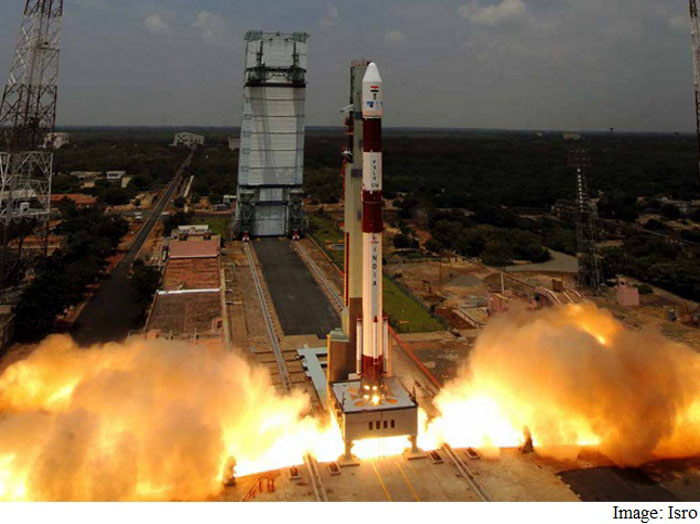
India's fourth navigation satellite will be launched on March 28 evening, the Indian space agency said on Monday.
According to Indian Space Research Organisation (Isro), the Indian rocket - Polar Satellite Launch Vehicle (PSLV-XL) - will blast off with the fourth satellite of the Indian Regional Navigation Satellite System (IRNSS) at 5.19 p.m. on March 28.
The 1,425 kg satellite is called IRNSS-1D and will be the first satellite to be put into orbit by an Indian rocket in 2015.
"The rocket has been moved to the launch pad or the umbilical tower. The rocket will be fixed to the umbilical tower," M.Y.S. Prasad, director of the Satish Dhawan Space Centre, told IANS over phone from Sriharikota.
India's only rocket port is located at Sriharikota in Andhra Pradesh around 80km from Chennai.
According to Prasad, after the rocket is connected to the umbilical tower system, checks would be carried out including full rocket and satellite checks.
Originally Isro had planned to launch the IRNSS-1D satellite on March 9.
But on March 4, Isro deferred the launch after it found that one of the telemetry transmitters in the IRNSS-1D was not working properly.
India has so far launched three regional navigational satellites as part of a constellation of seven satellites to provide accurate position information service to users across the country and the region, extending up to an area of 1,500km.
Though the full system comprises nine satellites - seven in orbit and two on the ground as stand-by - the navigation services could be made operational with four satellites, Isro officials had said.
Each satellite costs around Rs. 150 crores and the PSLV-XL version rocket costs around Rs. 130 crores. The seven rockets would involve an outlay of around Rs. 910 crores.
The entire IRNSS constellation of seven satellites is planned to be completed this year itself.
The first satellite IRNSS-1A was launched in July 2013, the second IRNSS-1B in April 2014 and the third on October 16, 2014.
Once the regional navigation system is in place, India need not be dependent on other platforms.
Meanwhile European space agency Arianespace is also getting ready to launch two Galileo satellites on March 27.
The two satellites would be launched jointly by a Soyuz rocket blasting off from French Guyana.
According to Arianespace, the Galileo programme is Europe's initiative for satellite navigation. Providing a highly accurate global positioning system under civilian control, it would consist of 30 satellites in total, along with European control centres and a worldwide network of sensor and uplink stations.
Quelle: NDTV
.
Update: 26.03.2015
-
Countdown Begins for Launch of IRNSS-1D
CHENNAI: The countdown for the lift of an Indian rocket with the country's fourth navigation satellite as the sole passenger began at 5.49 am today, the ISRO said.
According to Indian Space Research Organisation (ISRO), the 59 and half hours countdown for the launch of rocket Polar Satellite Launch Vehicle (PSLV-27) carrying Indian Regional Navigation Satellite System-IRNSS-1D began in the Sriharikota rocket port in Andhra Pradesh.
The rocket is expected to blast off at 5.19 pm on March 28 to put into orbit the 1,425 kg IRNSS-1D satellite.
India has so far launched three regional navigational satellites as part of a constellation of seven satellites to provide accurate position information service to users across the country and the region, extending up to an area of 1,500 km.
RELATED
India's Frugal Mars Mission Extended by Six Months
Isro's Mangalyaan Mars Orbiter Mission Extended for Another 6 Months
Isro to Launch Fourth Navigational Satellite IRNSS-1D on Saturday
Though the full system comprises of nine satellites - seven in orbit and two on the ground as stand-by - the navigation services could be made operational with four satellites, ISRO officials said.
Each satellite costs around Rs.150 crore and the PSLV-XL version rocket costs around Rs.130 crore. The seven rockets would involve an outlay of around Rs.910 crore.
The entire IRNSS constellation of seven satellites is planned to be completed this year itself.
The first satellite IRNSS-1A was launched in July 2013, the second IRNSS-1B in April 2014 and the third on October 16, 2014.
Once the regional navigation system is in place, India need not be dependent on other platforms.
Quelle: NDTV
-
Update: 27.03.2015
.

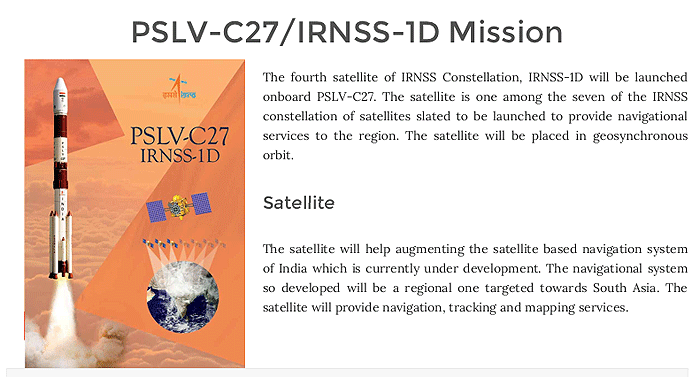
Quelle: ISRO
.
Update: 28.03.2015
.
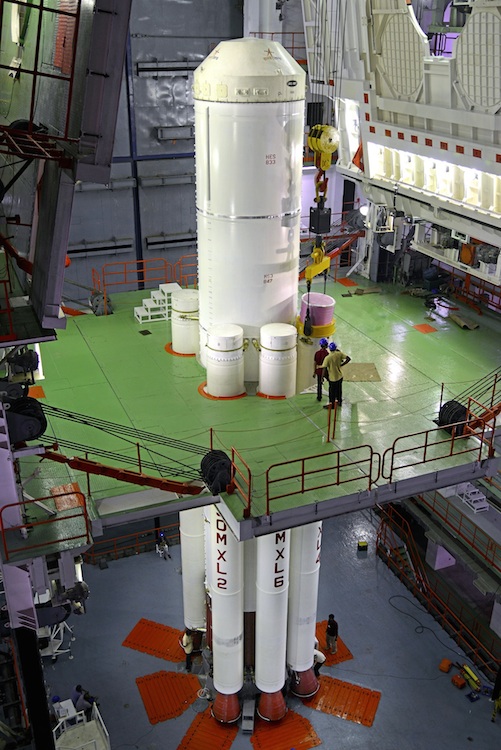
-
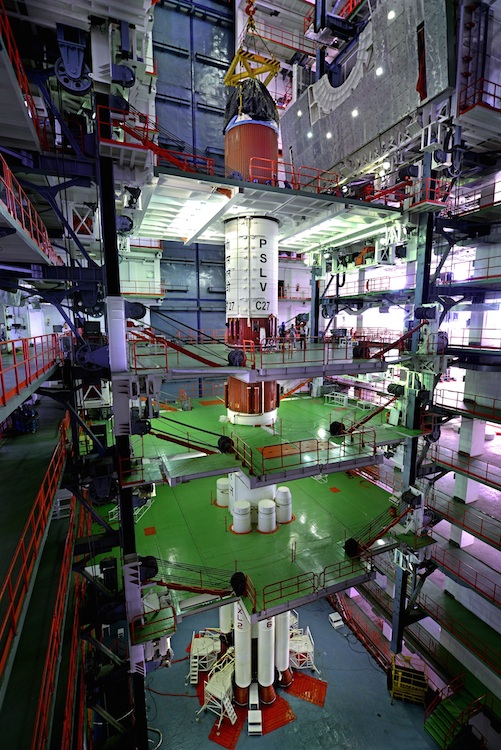
Launch of IRNSS-1D by PSLV-C27 on March 28, 2015
The launch of India’s fourth Navigation Satellite IRNSS-1D onboard PSLV-C27 in now scheduled at 1719 hrs IST in the evening on Saturday, March 28, 2015 from Satish Dhawan Space Centre, Sriharikota.
Quelle: ISRO
...
Update: 17.15 MEZ
.
Erolgreicher Start von PSLV-C27/IRNSS-1D Mission
The fourth satellite of IRNSS Constellation, IRNSS-1D was launched onboard PSLV-C27. The satellite is one among the seven of the IRNSS constellation of satellites slated to be launched to provide navigational services to the region. The satellite is placed in geosynchronous orbit.
Satellite
The satellite will help augmenting the satellite based navigation system of India which is currently under development. The navigational system so developed will be a regional one targeted towards South Asia. The satellite will provide navigation, tracking and mapping services.
-
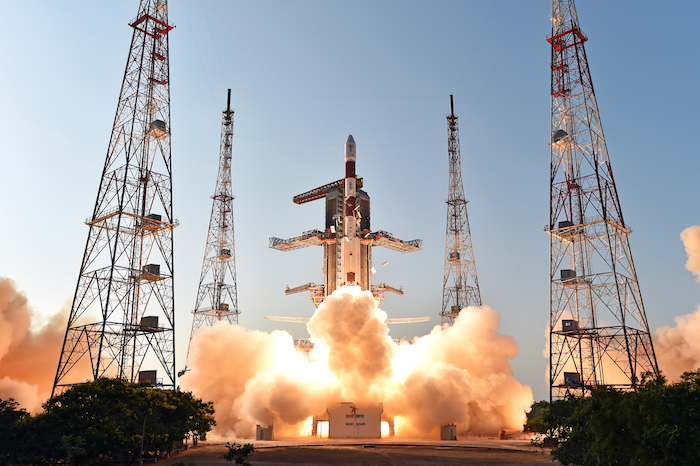
-
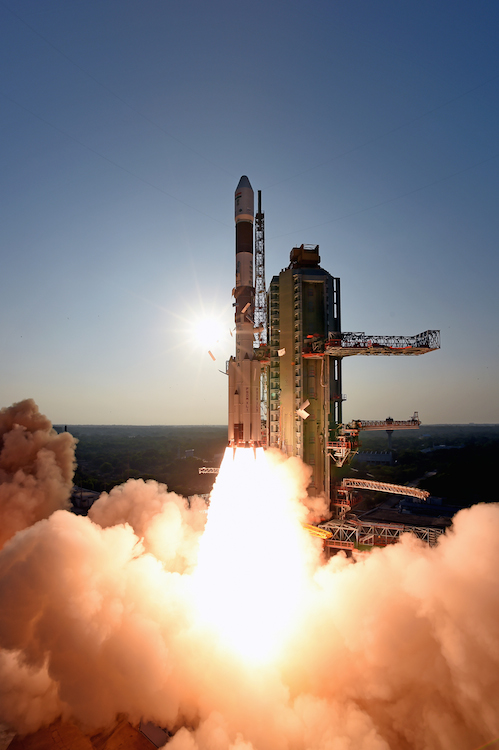
-
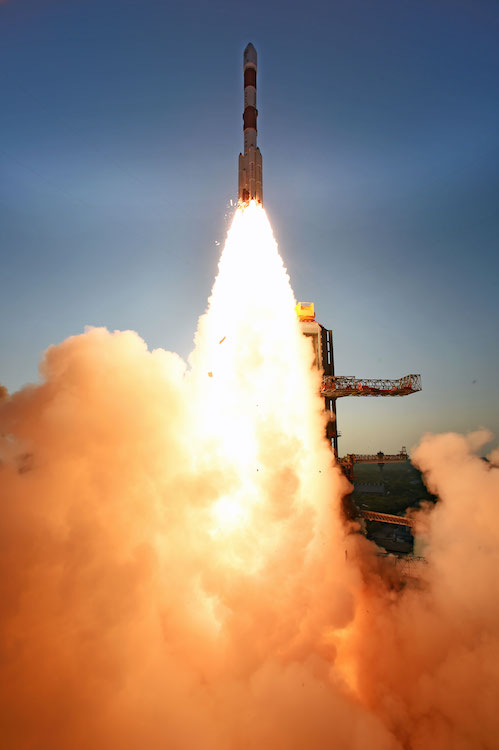
-

Quelle: ISRO
4346 Views
